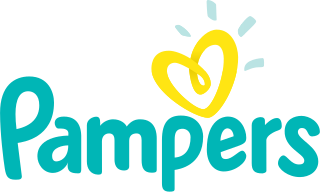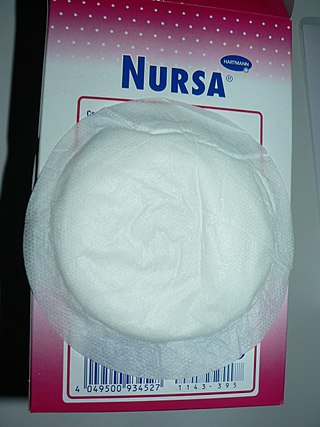
A diaper or a nappy is a type of underwear that allows the wearer to urinate or defecate without using a toilet, by absorbing or containing waste products to prevent soiling of outer clothing or the external environment. When diapers become wet or soiled, they require changing, generally by a second person such as a parent or caregiver. Failure to change a diaper on a sufficiently regular basis can result in skin problems around the area covered by the diaper.
Underpants are underwear worn on the lower body generally extending no higher than the navel. In British English they are often called simply pants. If a given pair of underpants has a wider waistband, it might bear the brand name of the manufacturer on it.

A swimsuit is an item of clothing designed to be worn by people engaging in a water-based activity or water sports, such as swimming, diving and surfing, or sun-orientated activities, such as sun bathing. Different types may be worn by men, women, and children. A swimsuit can be described by various names, some of which are used only in particular locations or for particular types of suit, including swimwear, bathing suit, bathing attire, swimming costume, bathing costume, swimming suit, swimmers, swimming togs, bathers, cossie, or swimming trunks, besides others.

Irritant diaper dermatitis is a generic term applied to skin rash in the diaper area that are caused by various skin disorders and/or irritants.

Pampers is an American brand for babies and toddlers products marketed by Procter & Gamble. This includes diapers, wipes and etc.

Competitive swimwear refers to the swimsuit, clothing, equipment, and accessories used in the aquatic sports of swimming, diving, artistic swimming, triathlon, and water polo.

Huggies is an American company that sells disposable diapers and baby wipes that is marketed by Kimberly-Clark. Huggies were first test marketed in 1968, then introduced to the public in 1977 to replace the Kimbies brand.

A bedpan or bed pan is a device used as a receptacle for the urine and/or feces of a person who is confined to a bed and therefore not able to use a toilet or chamber pot.

Training pants are undergarments used by incontinent people, typically toddlers, as an aid for toilet training. They are intended to be worn in between the transition between wearing diapers but before they are ready to wear regular underpants. Training pants may be reusable and made of fabric, or they may be disposable. In the US, disposable training pants may also be referred to as "pull-ups", and in the UK, training pants are frequently referred to as nappy pants or trainer pants. The main benefit of training pants over diapers is that unlike traditional diapers, they can be easily pulled down in order to sit on a potty or toilet, and pulled back up for re-use after the person has used the toilet. The main benefit of wearing training pants over regular underpants is that if the person has an accident, they do not soil their environment.

Luvs is a brand of disposable diapers made by Procter & Gamble. Luvs were sold as "Deluxe" diapers in the late 1980s. In 1994 they became budget diapers. The Luvs brand also includes baby wipes.

A cloth diaper or a cloth nappy, also known as reusable diaper or reusable nappy, is a diaper made from textiles such as natural fibers, human-made materials, or a combination of both. Cloth diapers are in contrast to disposable diapers, made from synthetic fibers and plastics. They are often made from industrial cotton which may be bleached white or left the fiber's natural color. Other natural fiber cloth materials include wool, bamboo, and unbleached hemp. Human-made materials such as an internal absorbent layer of microfiber toweling or an external waterproof layer of polyurethane laminate (PUL) may be used. Polyester fabrics microfleece or suedecloth are often used inside cloth diapers as a "stay-dry" wicking liner because of the non-absorbent properties of those synthetic fibers.

Cloth menstrual pads are cloth pads worn in the underwear to collect menstrual fluid. They are a type of reusable menstrual hygiene product, and are an alternative to sanitary napkins or to menstrual cups. Because they can be reused, they are generally less expensive than disposable pads over time, and reduce the amount of waste produced.

An adult diaper is a diaper made to be worn by a person with a body larger than that of an infant or toddler. Diapers can be necessary for adults with various conditions, such as incontinence, mobility impairment, severe diarrhea or dementia. Adult diapers are made in various forms, including those resembling traditional child diapers, underpants, and pads resembling sanitary napkins. Superabsorbent polymer is primarily used to absorb bodily wastes and liquids.
gDiapers are a hybrid diaper, so users can choose to use either a cloth insert or a disposable insert that can be flushed or composted. Co-founders are Jason and Kimberley Graham-Nye. gDiapers began being sold in 2004. gDiapers are licensed from Kuver Designs Pty Ltd, Tasmania, "Eenee designs" diapers.
A Maximum Absorbency Garment (MAG) is an adult-sized diaper with extra absorption material that NASA astronauts wear during liftoff, landing, and extra-vehicular activity (EVA) to absorb urine and feces. It is worn by both male and female astronauts. Astronauts can urinate into the MAG, and usually wait to defecate when they return to the spacecraft. However, the MAG is rarely used for this purpose, since the astronauts use the facilities of the station before EVA and also time the consumption of the in-suit water. Nonetheless, the garment provides peace of mind for the astronauts.
Marion O'Brien Donovan was an American inventor and entrepreneur. Recognized as one of the era's most prominent female inventors, she secured a total of 20 patents for her creations. In 1946, she created a reusable, impermeable diaper cover. Ultimately, this led to the invention of the disposable paper diaper, which was eventually commercialized by Victor Mills, the creator of Pampers. Donovan also innovated various solutions around the home and was inducted into the National Inventors Hall of Fame in 2015.

Bambino Mio is a brand of reusable nappies, manufactured and sold by a company of the same name based in Brixworth, Northamptonshire, UK. Bambino Mio nappies are widely used in the UK, and are sold in more than 70 countries.

A nursing pad is a cloth or disposable pad worn against the nipple and breast of a nursing mother to absorb any milk that may leak between feedings. It is inserted between the bra and the breast. Disposable pads are common and located easily online or in specialty stores. Reusable cloth pads can be washed and used over. These may be less expensive. Changing the pad when it is wet will keep the nipple clean and dry.
Depend is a Kimberly-Clark brand of absorbent, disposable undergarments for people with urinary or fecal incontinence. It positions its products as an alternative to typical adult diapers. Depend is the dominant brand of disposable incontinence garments in the United States with a 49.4 share of the market.
Splash About International Limited, usually referred to as Splash About, is best known as a designer, manufacturer and retailer of swimwear and swimming aids for children and babies, however the company also designs and makes maternity swimsuits. It operates from the United Kingdom.















